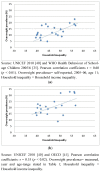Socioeconomic patterning of childhood overweight status in Europe
- PMID: 22690206
- PMCID: PMC3366624
- DOI: 10.3390/ijerph9041472
Socioeconomic patterning of childhood overweight status in Europe
Abstract
There is growing evidence of social disparities in overweight among European children. This paper examines whether there is an association between socioeconomic inequality and prevalence of child overweight in European countries, and if socioeconomic disparities in child overweight are increasing. We analyse cross-country comparisons of household inequality and child overweight prevalence in Europe and review within-country variations over time of childhood overweight by social grouping, drawn from a review of the literature. Data from 22 European countries suggest that greater inequality in household income is positively associated with both self-reported and measured child overweight prevalence. Moreover, seven studies from four countries reported on the influence of socioeconomic factors on the distribution of child overweight over time. Four out of seven reported widening social disparities in childhood overweight, a fifth found statistically significant disparities only in a small sub-group, one found non-statistically significant disparities, and a lack of social gradient was reported in the last study. Where there is evidence of a widening social gradient in child overweight, it is likely that the changes in lifestyles and dietary habits involved in the increase in the prevalence of overweight have had a less favourable impact in low socio-economic status groups than in the rest of the population. More profound structural changes, based on population-wide social and environmental interventions are needed to halt the increasing social gradient in child overweight in current and future generations.
Keywords: Europe; child; overweight; social gradient.
Figures
References
-
- Martinez J.A., Kearney J.M., Kafatos A., Paquet S., Martinez-Gonzalez M.A. Variables independently associated with self-reported obesity in the European Union. Public Health Nutr. 1999;2:125–133. - PubMed
-
- Molarius A., Seidell J.C., Sans S., Tuomilehto J., Kuulasmaa K. Educational level, relative body weight, and changes in their association over 10 years: An international perspective from the WHO MONICA Project. Am. J. Public Health. 2000;90:1260–1268. doi: 10.2105/AJPH.90.8.1260. - DOI - PMC - PubMed
-
- Cavelaars A.E., Kunst A.E., Mackenbach J.P. Socio-economic differences in risk factors for morbidity and mortality in the European Community: An international comparison. J. Health psychol. 1997;2:353–372. - PubMed
-
- Mackenbach J.P., Stirbu I., Roskam A.J., Schaap M.M., Menvielle G., Leinsalu M., Kunst A.E. European Union Working Group on Socioeconomic Inequalities in Health. Socioeconomic inequalities in health in 22 European countries. N. Engl. J. Med. 2008;358:2468–2481. doi: 10.1056/NEJMsa0707519. - DOI - PubMed
-
- Giskes K., van Lenthe F.J., Turrell G., Kamphuis C.B., Brug J., Mackenbach J.P. Socioeconomic position at different stages of the life course and its influence on body weight and weight gain in adulthood: A longitudinal study with 13-year follow-up. Obesity (Silver Spring) 2008;16:1377–1381. doi: 10.1038/oby.2008.54. - DOI - PubMed
MeSH terms
LinkOut - more resources
Full Text Sources



